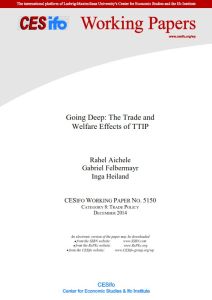Acesse a sua conta getAbstract para obter o resumo!

Acesse a sua conta getAbstract para obter o resumo!
Rahel Aichele, Gabriel Felbermayr and Inga Heiland
Going Deep
The Trade and Welfare Effects of TTIP
CESifo Group Munich, 2014
Sobre o que é?
The Transatlantic Trade and Investment Partnership concerns more than just Parmesan cheese and chlorine-soaked chicken.
Recommendation
While trade deals may seem the driest of subjects, the Transatlantic Trade and Investment Partnership (TTIP) has evoked some emotional responses on both sides of the Atlantic, as debates over the geographical identification of Parmesan cheese or the suitability of chlorine-soaked chicken attest. But this study from researchers Rahel Aichele, Gabriel Felbermayr and Inga Heiland of the Ifo Institute at the University of Munich assesses the EU-US trade talks in economic terms and proffers some theories about which countries might gain and which might lose. getAbstract recommends this scholarly report to those seeking more light than heat about the TTIP.
Summary
About the Authors
Rahel Aichele and Gabriel Felbermayr are economists at the Ifo Institute at the University of Munich, where Inga Heiland is a junior economist and doctoral student.






















Comment on this summary